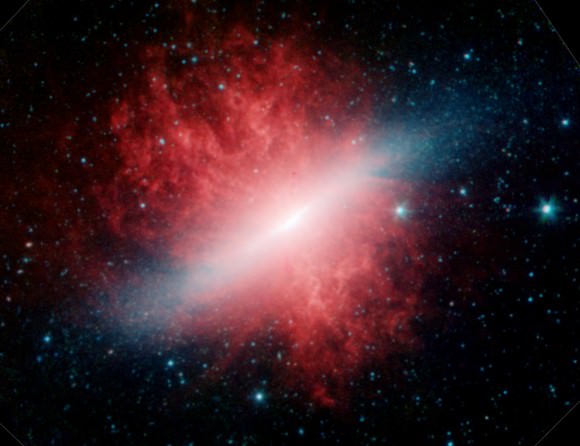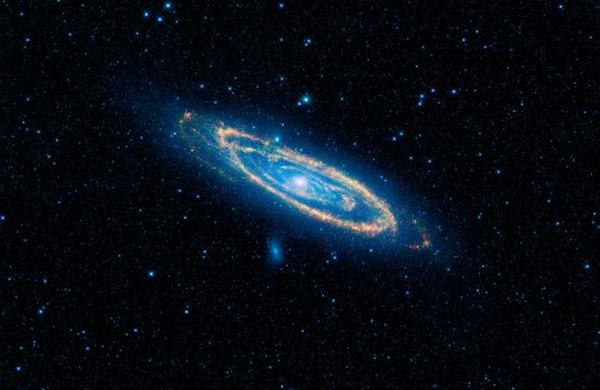Beam us up, Scotty. There’s no signs of intelligent life out there. At least, no obvious signs, according to a recent survey performed by researchers at Penn State University. After reviewing data taken by the NASA Wide-field Infrared Survey Explorer (WISE) space telescope of over 100,000 galaxies, there appears to be little evidence that advanced, spacefaring civilizations exist in any of them.
First deployed in 2009, the WISE mission has been able to identify thousands of asteroids in our solar system and previously undiscovered star clusters in our galaxy. However, Jason T. Wright, an assistant professor of astronomy and astrophysics at the Center for Exoplanets and Habitable Worlds at Penn State University, conceived of and initiated a new field of research – using the infrared data to assist in the search for signs of extra-terrestrial civilizations.
And while their first look did not yield much in the way of results, it is an exciting new area of research and provides some very useful information on one of the greatest questions ever asked: are we alone in the universe?
“The idea behind our research is that, if an entire galaxy had been colonized by an advanced spacefaring civilization, the energy produced by that civilization’s technologies would be detectable in mid-infrared wavelengths,” said Wright, “exactly the radiation that the WISE satellite was designed to detect for other astronomical purposes.”
This logic is in keeping with the theories of Russian astronomer Nikolai Kardashev and theoretical physicist Freeman Dyson. In 1964, Kardashev proposed that a civilization’s level of technological advancement could be measured based on the amount of energy that civilization is able to utilize.

To characterize the level of extra-terrestrial development, Kardashev developed a three category system – Type I, II, and III civilizations – known as the “Kardashev Scale”. A Type I civilization uses all available resources on its home planet, while a Type II is able to harness all the energy of its star. Type III civilizations are those that are advanced enough to harness the energy of their entire galaxy.
Similarly, Dyson proposed in 1960 that advanced alien civilizations beyond Earth could be detected by the telltale evidence of their mid-infrared emissions. Believing that a sufficiently advanced civilization would be able to enclose their parent star, he believed it would be possible to search for extraterrestrials by looking for large objects radiating in the infrared range of the electromagnetic spectrum.
These thoughts were expressed in a short paper submitted to the journal Science, entitled “Search for Artificial Stellar Sources of Infrared Radiation“. In it, Dyson proposed that an advanced species would use artificial structures – now referred to as “Dyson Spheres” (though he used the term “shell” in his paper) – to intercept electromagnetic radiation with wavelengths from visible light downwards and radiating waste heat outwards as infrared radiation.
“Whether an advanced spacefaring civilization uses the large amounts of energy from its galaxy’s stars to power computers, space flight, communication, or something we can’t yet imagine, fundamental thermodynamics tells us that this energy must be radiated away as heat in the mid-infrared wavelengths,” said Wright. “This same basic physics causes your computer to radiate heat while it is turned on.”

However, it was not until space-based telescopes like WISE were deployed that it became possible to make sensitive measurements of this radiation. WISE is one of three infrared missions currently in space, the other two being NASA’s Spitzer Space Telescope and the Herschel Space Observatory – a European Space Agency mission with important NASA participation.
WISE is different from these missions in that it surveys the entire sky and is designed to cast a net wide enough to catch all sorts of previously unseen cosmic interests. And there are few things more interesting than the prospect of advanced alien civilizations!
To search for them, Roger Griffith – a postbaccalaureate researcher at Penn State and the lead author of the paper – and colleagues scoured the entries in the WISE satellites database looking for evidence of a galaxy that was emitting too much mid-infrared radiation. He and his team then individually examined and categorized 100,000 of the most promising galaxy images.
And while they didn’t find any obvious signs of a Type II civilization or Dyson Spheres in any of them, they did find around 50 candidates that showed unusually high levels of mid-infrared radiation. The next step will be to confirm whether or not these signs are due to natural astronomical processes, or could be an indication of a highly advanced civilization tapping their parent star for energy.

In any case, the team’s findings were quite interesting and broke new ground in what is sure to be an ongoing area of research. The only previous study, according to the G-HAT team, surveyed only about 100 galaxies, and was unable to examine them in the infrared to see how much heat they emitted. What’s more, the research may help shed some light on the burning questions about the very existence of intelligent, extra-terrestrial life in our universe.
“Our results mean that, out of the 100,000 galaxies that WISE could see in sufficient detail, none of them is widely populated by an alien civilization using most of the starlight in its galaxy for its own purposes,” said Wright. “That’s interesting because these galaxies are billions of years old, which should have been plenty of time for them to have been filled with alien civilizations, if they exist. Either they don’t exist, or they don’t yet use enough energy for us to recognize them.”
Alas, it seems we are no closer to resolving the Fermi Paradox. But for the first time, it seems that investigations into the matter are moving beyond theoretical arguments. And given time, and further refinements in our detection methods, who knows what we might find lurking out there? The universe is very, very big place, after all.
The research team’s first research paper about their Glimpsing Heat from Alien Technologies Survey (G-HAT) survey appeared in the Astrophysical Journal Supplement Series on April 15, 2015.
Further Reading: Astrophysical Journal via EurekAlert, JPL-NASA


I read this and re-read this and wondered, “Why are you expecting ‘energy signatures’ from a life form from a galaxy 100’s of 1,000,000’s of Light Years away?
Seriously, think about this. You are expecting ‘energy readings’ that in all likely hood have not ‘reached here yet’ – because IF the life form even started 500,000 years ago – in a distant galaxy, the light energy you are expecting would not have made the trek here just yet.
Also there is the assumption that the energy is strong enough, from another galaxy to has not ‘burn out’ before it even got to the edge of their galaxy, yet along the distance between galaxies.
Here is the thing:
Take Earth — Let’s say we want to see ” energy signatures ” from Earth, oh, say, 1,000 LY away. You would either have to see “now” 1,000 years into the future – or you would be seeing “energy” from a 1,000 years in the past.
So let’s just state: 950 AD for argument sake. How much “energy” would you see from Earth in the 950 AD?
The problem is that the light from many stars reach our telescopes after a light travel time across an interval of 10 to some 10,000 years from billions of stars within range. It is worse than having Clinton debate with king Sargon of Mesopotania 2200 b.c. “One in a million” is not a figure of speech here, it is pure math. Me too, I am very sorry.
And for galaxies it gets worse. If no one ever anywhere decorated their home galaxy, odds are that we never will. The interesting question is: what will stop, or divert, us?
There’s a hypothesis that the Universe is becoming more habitable over time. Heavy elements, which living things require, were less plentiful in the past. Also gamma ray bursts, which can sterilize huge tracts of real estate, may have been more common in the past. It may be that we are among the first civilizations to emerge.
I truly love articles such as this one. It’s science fiction at its best to be sure. Obviously, 13 billion years hasn’t been sufficient time for life to produce the “Kardashev Scale” (Stg.1, Stg. 2 and Stg. 3). Dreaming is a good thing. Many ‘dreams’ have produced good things.
My take is that man will continue to collect much data that will open new doors in physics that in turn, will continue to show the life forms man is expecting to find are truly out there but not in the visible spectrum we see, feel, touch, taste and explore, in this marvelous shell (Our Universe) we fortunately have been placed (on puropse).
“…none of them is widely populated by an alien civilization using most of the starlight in its galaxy for its own purposes”
I’m wondering why he only mentions starlight. It seems more likely civilizations will just utilize their own fusion reactors instead, for much simpler energy production rather than some impossibly huge giga-sphere around a natural fusion reactor. Once developed, even consuming a tiny moon would yield unimaginable amounts of energy. But regardless, I think the heat trace should be there all the same.
The thing that people don’t like to concede is that while we may not be completely alone, advanced life may be ultra-rare. We could well be the only one in our galaxy, or one of just a few, for instance. This too would of course explain both the infrared data and lack of any evidence or encounter.
This question, I believe, is answered by Wright in one of a series of articles on a blog of the researchers. Apparently it has to do with the free energy available from a star being orders of magnitude greater than that available from converting the other matter in the solar system to energy.
Really interesting set of articles:
http://sites.psu.edu/astrowright/the-g-hat-search-for-kardashev-civilizations/
He’s just… wrong. If you have the technology to create a Dyson sphere (which is absurdly high), you have the technology to siphon gas off a star. A fusion reactor ~50 miles in diameter could conceivable create more energy than a star like our sun.
To put it another way, consider this: we know that naturally occurring fission reactors have existed on Earth in the past. (There used to be enough U235 to make this possible). If such a reactor existed today, in Europe (where we see the remains of one of them), would the entire world be running off of that reactor? The answer is a resounding “no!” for several reasons:
1) The energy density of a naturally occurring fission rector is really, really low. Too low to be useful on a large scale. You’d need to expend enormous resources to capture all the energy coming out of such a reactor. Just like stars (natural fusion reactors).
2) It would be hard to run, say, Brazilian cities off a European power source. It’s just not where we need it to be for 100% of our needs, and it can’t be moved. Just like stars.
3) We have the technology to build fission reactors that are absolutely tiny in comparison to those natural reactors that put off far more energy. Just like fusion reactors and stars.
4) None of this means that we wouldn’t use the fission reactor on a small scale. But then, we *already* do that with our friendly local fusion reactor (solar power), no Dyson sphere or swarm necessary.
In short, there is no reason to *ever* build a Dyson sphere. Any civilization capable of building one would be advanced enough to have better ways of creating that much power, with far more convenience.
That sounds like a very sensible argument . . . . the simpler things are the better, is usually the case of technology.
And this assumes advanced civilizations continue to use regular matter as their source of energy. What if they instead use dark matter or dark energy as their energy source? The universe could be aglow with signs of extra terrestrial energy use, but we couldn’t even begin to detect it.
And… are you frustrted that those existing lifeforms don’t watch the Kardasians on their TV? Distance =time, so we’re “too early” with our search… simple.
The Cosmos is Full of Life way more advanced than we are or will ever be.. We are looking for Coal Fires when they are using Dark Energy or something even more Exotic there are Millions of Planets in our Own Galaxy which are Teaming with Life, Look up to the Heavens for we are there 🙂 Amen
* BLINKS *
Please site a valid source for this information. I understand ‘faith based’ – but seriously – Where is your evidence of your statement?
Strange how ‘they’ are always M.I.A., when you need them ‘put up’ ….
. o O (Just saying)
The obvious question is if we could be in a nearby galaxy and aimed this at Earth, would we see signs of life on Earth? If we could put this telescope in a galaxy near the edge of it’s vision could we detect signs of life on Earth? My guess is no. So, their still could be life out in the Universe. Just they are much like us. Stranded on their home world, never being able to leave.
After reading the other responses, I am beginning to wonder if the author left out something?? IE: Some thought / reason behind this.
Because as stated, obviously this is shot down in so many different ways, I had to wonder if they were smoking or drinking something. Because logic just simply says, the as stated premise just does NOT work with any kind of Physics at all ….
So are we missing something that should have been stated in this article?
My first thought is somebody is doing a thesis and needed an important topic to write about. With data available but never used in this manner, this makes for a very interesting academic paper. But realistically had almost no chance of success. Still, there are a couple of very good candidates, so we’ll see.
All this demonstrates is that Dyson spheres were not found. The 1940’s scientifiction notion of civilizations that would have the spare energy and desire to re-build their solar systems is a fantasy, and not a believable one at that. If we do find ETIs it is doubtful that any of them will be found to have been predicted in stories in Analog Magazine. I see plenty of signs suggestive of life in the near universal presence of molecular clouds with water, carbon compounds and an abundance of habitats for life to emerge. We aren’t alone on earth as intelligent beings, and have more or less chosen to ignore or hunt our non-threatening closest relatives into extinction. Doesn’t that say as much about our intelligence as do our telescopes?
I don’t think we need to succumb to self-loathing and pessimism just yet.